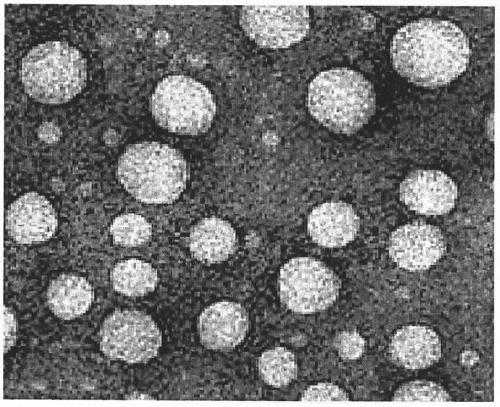Preparation method of urushiol-loading pH responsive amphiphilic copolymer micelle
An amphiphilic copolymer, responsive technology, used in the field of biomedicine to achieve the effects of good stability, simple operation and improved water solubility
- Summary
- Abstract
- Description
- Claims
- Application Information
AI Technical Summary
Problems solved by technology
Method used
Image
Examples
Embodiment 1
[0034] Synthesis of Amphiphilic Copolymer Polyethylene Glycol-Poly β-Amino Ester (mPEG-PBAE)
[0035] Take a certain amount of methoxypolyethylene glycol with amino groups at the end, hydrophobic amine monomer, 5-amino-1-pentanol and 1,4-butanediol diacrylate and dissolve them in dimethyl sulfoxide to form a concentration It is a 0.2mg / mL reaction solution, put it in a polymerization tube and stir at 60°C for 20-48 hours, then add a certain amount of 1,3-pentanediamine, and continue the reaction for 24 hours. Dilute, wash with deionized water three times, separate the organic phase, dry over anhydrous magnesium sulfate, filter the organic phase, remove the solvent by rotary evaporation of the filtrate, and dry in vacuum at 40°C for 20-48 hours to obtain the target amphiphilic copolymer.
[0036] The number-average molecular weight Mn of the methoxypolyethylene glycol with amino groups at the end is 2000 or 5000.
[0037] The molar ratio of methoxypolyethylene glycol with amin...
Embodiment 2
[0044] Preparation of pH-responsive amphiphilic copolymer micelles loaded with urushiol
[0045] Accurately weigh 40-100 mg of polyethylene glycol-poly-β-amino ester amphiphilic copolymer and urushiol each, dissolve them in 4-10 mL of N, N'-dimethylformamide, mix them uniformly by ultrasonic and pour into In a dialysis bag with a molecular weight of 3000, dialyze with 1.0-2.0L deionized water for 20-30 hours, and change the water every 1-2 hours; The supernatant was filtered through a water membrane with a pore size of 0.45 μm to remove unencapsulated urushiol; finally, the filtrate was freeze-dried at -40°C to -45°C for 24h to 36h to obtain pH-responsive amphiphilic copolymers loaded with urushiol micelles.
[0046] The present invention has studied urushiol and copolymer charging amount (A), N, N'-dimethylformamide solvent consumption (B) in the preparation technology of the copolymer micelle of loaded urushiol by adopting star point design-response surface optimization met...
Embodiment 3
[0051] Determination of Morphology, Particle Size and Zeta Potential of Urushiol-loaded Copolymer Micelles
[0052] The present invention adopts transmission electron microscope (TEM) to characterize the morphology of loaded urushiol copolymer micelle; Adopt dynamic light scattering method (DLS) to measure particle diameter and Zeta potential of loaded urushiol copolymer micelle, transmission electron microscope result The results showed that the appearance of drug-loaded micelles was relatively round, with regular spherical structure, uniform size and good dispersion. DLS measurement results showed that the average particle size of urushiol-loaded copolymer micelles was 140-160nm, which could penetrate tumor tissue more effectively, improve penetration ability and achieve targeted aggregation at tumor sites through the EPR effect. The zeta potential value is 32-35mV, which shows that it has good stability. The positive charge it carries helps it bind to the negatively charged...
PUM
| Property | Measurement | Unit |
|---|---|---|
| particle size | aaaaa | aaaaa |
| particle size | aaaaa | aaaaa |
| electric potential / voltage | aaaaa | aaaaa |
Abstract
Description
Claims
Application Information
 Login to View More
Login to View More - R&D
- Intellectual Property
- Life Sciences
- Materials
- Tech Scout
- Unparalleled Data Quality
- Higher Quality Content
- 60% Fewer Hallucinations
Browse by: Latest US Patents, China's latest patents, Technical Efficacy Thesaurus, Application Domain, Technology Topic, Popular Technical Reports.
© 2025 PatSnap. All rights reserved.Legal|Privacy policy|Modern Slavery Act Transparency Statement|Sitemap|About US| Contact US: help@patsnap.com



